
The Ancient Philosophy of the Bhagavad Gita, Song of God
The Bhagavad Gita is one of the most important religious texts in Hinduism as well as one of the most seminal religious texts in the world, alongside the Bible, the Quran, the Torah and the Ramayana. It is framed around a conversation between Krishna and a warrior right before a major battle. It is traditionally believed to be a record of what was apparently a very productive conversation.
The Bhagavad Gita contains many of the core ideas and theological and philosophical concepts that are prevalent in Hinduism today. These ideas also correlate with the philosophical and moral teachings of other religions.
Background of the Bhagavad Gita
The title Bhagavad Gita translates to “Song of God,” or “Song to the Supreme Being”. The Bhagavad Gita was written sometime between 400 BC and 200 AD and is part of a larger work, the Mahabharata. The Mahabharata is one of two great epic Sanskrit poems, the other being the Ramayana.
Indian civilization, as it is known today, can be traced back to the Indus River Valley Civilization which flourished between 2500 BC and 1500 BC. The Indus River Valley Civilization is known for major urban centers, such as Mohenjo-Daro and Harappa. This civilization was probably pre-Indo-European and appears to have had a system of writing, though this system of writing is yet to be decoded.
Little is known about the Indus River Valley Civilization, but archaeologists and prehistorians believe that its founders were probably related to the Dravidian-speaking peoples of southern India and they may have had connections with the ancient Sumer in Mesopotamia. It is likely that trade networks existed between Mesopotamia and the Indus River Valley at the time, allowing for goods and ideas to be exchanged between the two centers of urban civilization.
It is unknown how much of the Indus River Valley Civilization is preserved in modern Indian culture, but statues dating to the time of the Indus River Valley Civilization depict what appear to be human figures in known yoga positions. Furthermore, there is archaeological evidence that ritual bathing was practiced during that time, a practice that is still important in modern Hinduism.
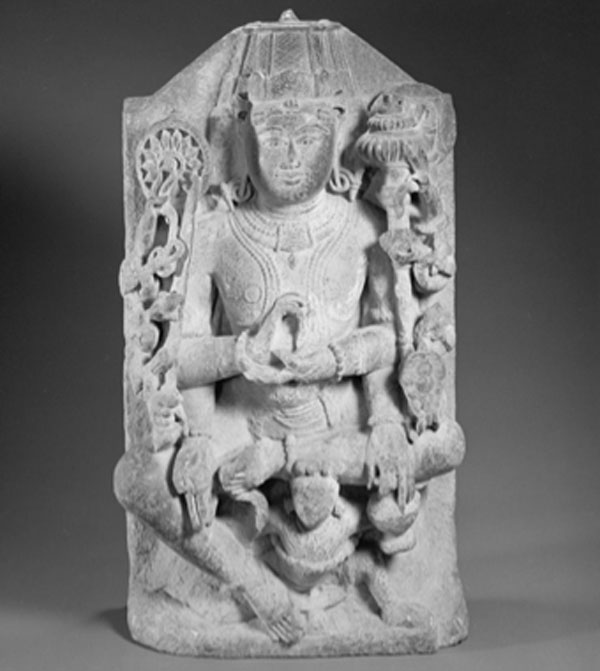
12th century sculpture showing one of the yoga positions from the Bhagavad Gita. (Fæ / Public Domain)
It has been suggested by scholars that forms of yoga as well as ancient Indian religions, such as Jainism and Hinduism, may have historical connections to the Indus River Valley Civilization.
The next major development in Indian civilization was the arrival of the Indo-Aryans around 1500 BC. The Indo-Aryans spoke an Indo-European language which later became Sanskrit. The Indo-Aryans introduced the Vedas which is a collection of Hindu scriptures.
The focus of Vedic religion was the fire alter and offerings made to the gods in return for the well-being of their worshipers. The Indo-Aryans are also known for having introduced the basis of the caste system in India.
The date of the Bhagavad Gita is open to debate. Some scholars believe that it was written at the same time as the rest of the Mahabharata while others believe that it was added centuries later by devotees of Krishna. Either way, most scholars believe that it post-dates the life of Siddhartha Gautama.
Context of the Bhagavad Gita within the Mahabharata
The Bhagavad Gita is a smaller section of the epic poem, the Mahabharata. The Mahabharata contains numerous myths and legends about gods and heroes in Hinduism. It also contains large sections of philosophical and theological discussion.
The events in the Mahabharata are traditionally believed to have occurred around 3102 BC, but historians are uncertain when the events in the Mahabharata took place. Some scholars believe that the events that inspired the legendary story of the Mahabharata most likely occurred in 1500 BC or even 900 BC.
- The Hindu sacred texts about human origins
- 3: The Perfect Number - Trinity Symbolism in World Religious Traditions
- Saraswati: Hindu Goddess of Aesthetics and Protector of the Universe

Manuscript illustration of the Battle of Kurukshetra in the Mahabharata. (Ranveig / Public Domain)
The Mahabharata revolves around a war between two rival lines of cousins vying for control of their kingdom. It begins when the elder of two brothers is denied the throne because he is blind. Kingship goes to his younger brother, Pandu. Unfortunately, Pandu is found to be infertile, due to a curse, and his wife prays to the gods to provide children on his behalf.
The gods oblige, leading to the Pandavas, or sons of Pandu, which include the warrior Arjuna. Meanwhile, Pandu’s brother continues to have children, the Kauravas. The Kauravas believe themselves to be the rightful rulers of the kingdom so they force the Pandavas into exile.
During their exile, the Pandavas find another one of their cousins, Krishna, who ends up joining them. Eventually, the feud between the Pandavas and the Kauravas leads to open war which culminates on the battlefield of Kurukshetra.
On the eve of a battle at Kurukshetra, Arjuna, and the Pandavas are about to fight and kill the Kauravas when Arjuna hesitates. He realizes the people he is about to fight are his kinsmen and he questions the morality of his actions. He turns and shares this with his charioteer, Krishna.
Krishna, in response, has a long discussion with Arjuna about metaphysics, theology, and ethics. This next part makes up the bulk of the Bhagavad Gita. Krishna concludes by telling Arjuna that it is his duty to act with justice which in some cases may mean going to war, even with family members.
Krishna lays out many of the central teachings of classical Hinduism as well as the different yogic paths. Most Hindus consider the Bhagavad Gita to be foundational to Hindu philosophy and theology.
Theology and Metaphysics of the Bhagavad Gita
Krishna explains to Arjuna the nature of Brahman, that he, or it, is the unchanging reality underlying the changing world. Brahman is at once the pure transcendent Self and the immanent force pervading and sustaining all reality. The supreme being is also just as present in the individual person.

Krishna and Arjuna at Kurukshetra, as told in the Bhagavad Gita. (Aavindraa / Public Domain)
Humans are primarily able to understand Brahman through atman, which is human nature. Atman represents the changeless, immortal soul which does not die. The physical body will change and decay, but the soul will remain unchanged going from body to body.
Atman represents the true Self having transcended all the temporary things in life with which humans define themselves, fame, occupation, status, etc. These things are temporary and changing and thus cannot really define the true self.
Atman is the true Self apart from all temporary, changing things, and selfish desires that they create. A person finds true freedom when he frees himself from attachment to temporary, that is, worldly things.
Yogic Paths and Philosophies of the Bhagavad Gita
The central problem of human existence, according to the Bhagavad Gita, is that people allow themselves to be attached to their physical desires. Human beings have a physical body, but the true Self is the soul, or atman, not the physical body.
Material and worldly things are related to the physical body not the soul, and pursuit of worldly things that please the senses will not satisfy the soul. The soul can only be satisfied with things that are immaterial, that is, the pursuit of God. God, in this case, is defined as the pure unadulterated, undifferentiated Self.
- The Past Teaching the Present: Ancient Sanskrit Texts Discuss the Importance of Environmental and Species Conservation
- What is a Lingam and How Does It Represent Shiva?
- Temple of Arul Mihu Navasakthi Vinayagar: Colorful Worship in Seychelles Paradise
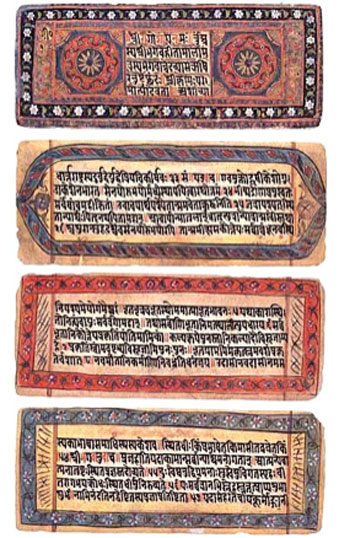
A 19th-century Sanskrit manuscript of the Bhagavad Gita. (Abhishekjoshi / Public Domain)
The material world is considered an illusion or dream of souls that still find themselves attached to false things like family, wealth, and status. Their concept of Self is based in illusions and, as a result, they do not truly know themselves.
The point that Krishna is making is not that the material world does not matter, but that it only matters in relation to God. Everything in life is to be an instrument in helping us to relate to God, that is, the true Self. Essentially, to know or commune with God means self-realization.
The Self in Hinduism, as opposed to ‘self,’ refers to the universal Self which pervades everything and the being in which all other beings are contained. All other beings are simply manifestations of this greater being. A person attains true self-realization when he realizes that there is no difference between the true individual Self and the transcendent, universal Self which is God.
Pursuit of God can be done through yoga. Yoga, in this case, simply means any sort of spiritual discipline that allows a person to become one with God, or the true Self. Krishna defines three paths or yogic philosophies, Jnana (self-knowledge) Yoga, Karma (action) Yoga, and Bhakti (devotion) Yoga.
Jnana Yoga
Jnana can be defined as self-knowledge. Freedom from attachment is not possible without knowledge. In order to be free from attachment and physical desires, a person must be able to discern the temporary from the eternal and the real from the unreal. Attachment dilutes a person’s ability to think clearly about himself.
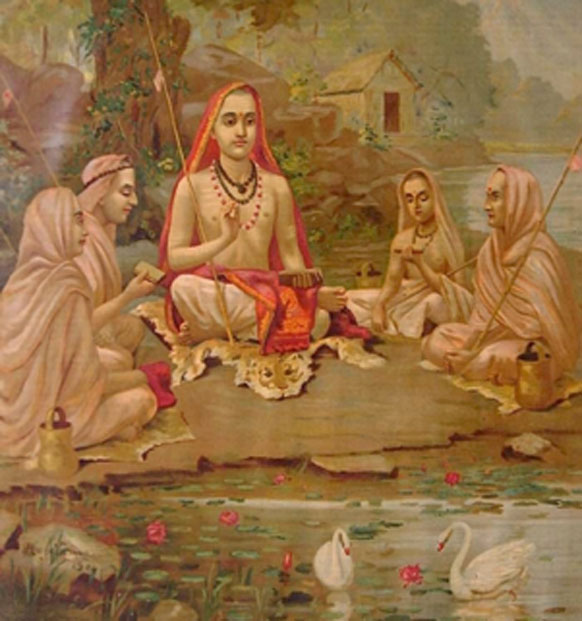
Jnana yoga is one of the several spiritual paths in the Bhagavad Gita, it emphasizes the ‘path of knowledge’ also known as the ‘path of self-realization’. (Nvvchar / Public Domain)
Jnana yoga is achieved when a person realizes that all the worldly things used to define self, such as wealth, fame, status, etc., are all illusions and do not really define the true self. Once he has this knowledge, he can gain a true understanding of the divine and achieve true self-realization or moksha.
Karma Yoga
The word ‘karma’ simply means action. Karma yoga involves the right action according to dharma. Dharma refers to the underlying order that determines how the cosmos is structured and how people are supposed to behave. The way of karma involves acting in a way that is completely unattached to the consequences of that action.
An action should or should not be done based on whether or not it is right and not because of potential benefits or consequences. Someone should never act when he is attached to the consequences of that action. The person must be entirely unconcerned with what he might gain or lose in worldly terms, simply acting out of what is right, in other words, in accordance with dharma.
Bhakti Yoga
Bhakti means devotion. This refers to an unattached, selfless devotion to the divine. The Bhakti yogic route involves performing karma as well as religious rituals and disciplines as acts of devotion to the divine. These acts of devotion, whether they take the form of acts of religious service to God, sacrificial offerings, or dances and ceremonies, must also be done without attachment, that is they must be entirely selfless and done without the expectation of receiving anything in return.
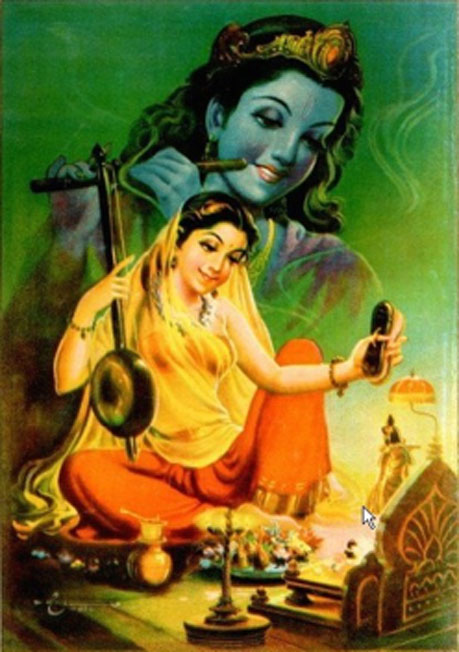
Meerabai is considered as one of the most significant saints in the Vaishnava bhakti yoga tradition. (Kalki / Public Domain)
Legacy of the Bhagavad Gita
Because of the theological and philosophical expositions found within the Bhagavad Gita, the text is considered an important introduction to Hinduism. The Bhagavad Gita is considered tradition, as opposed to scripture, but it is still considered important within Hindu communities as well as outside of Hinduism.
Western thinkers have also been influenced by the teachings of the Bhagavad Gita. The theoretical physicist J. Robert Oppenheimer is famous for having used a quote from the Bhagavad Gita upon witnessing the first test of the nuclear bomb, “now I (am become) Death, Destroyer of Worlds”. Oppenheimer considered the Bhagavad Gita to be the central text that shaped his personal philosophy.
There is also evidence that, recently, the ancient text is becoming popular among businessmen as a source of spiritual guidance, replacing the Art of War which was popular in the 1980s and 1990s.
Many of the teachings within the Bhagavad Gita also have parallels in other religions. The Abrahamic faiths, for example, also emphasize that true human happiness is gained through communion with the divine.
Of course, the Abrahamic conception of God is very different from the conception of God in the Bhagavad Gita. The focus on the divine, however, is the same, despite the significant difference in how the respective traditions define God.
Furthermore, other religions, such as Sikhism and Buddhism, also teach that attachment to material or temporary things is a source of human suffering and unhappiness and advocate detachment from the material world. Christianity, Islam, and Judaism have a very similar teaching, though they use a different word for attachment: idolatry.
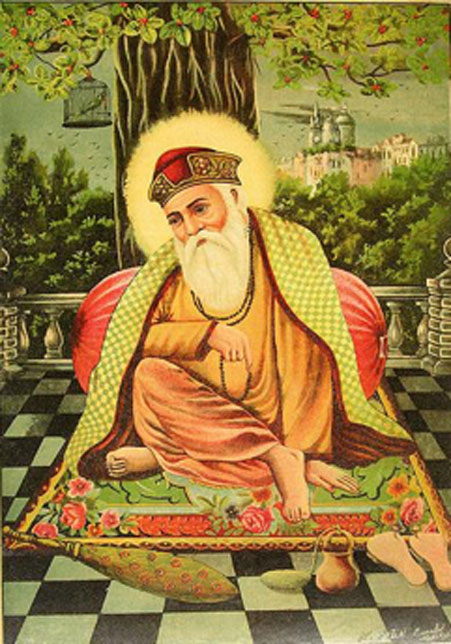
Guru Nanak was the founder of the religion of Sikhism. (Napoleon 100 / Public Domain)
This teaching is also echoed in psychological research which has shown that people who are materialistic and spend their lives pursuing material wealth, career success, and status in order to define themselves are perpetually unhappy and unsatisfied. Relationships and serving others, on the other hand, is correlated with satisfaction which affirms the teachings of most major religious traditions, including the Bhagavad Gita.
The universality of some of the teachings of the Bhagavad Gita, such as the folly of attachment to material things, and the importance of pursuing the divine, does not necessarily mean that everything in the Bhagavad Gita is true, but it does show that the Bhagavad Gita reflects something that seems to be a universal feature of the human religious consciousness. The Bhagavad Gita affirms the human desire to be a part of something beyond the idiosyncratic, individual Self as defined by the limitations of biology, economics, and culture.
Top image: The Bhagavad Gita. Source: Arnub Dutta / CC BY-SA 3.0
By Caleb Strom
References
Doniger, W. 2019. Mahabharata. Encyclopaedia Britannica. [Online] Available at: https://www.britannica.com/topic/Mahabharata
Greene, E. 2014. MODERN IMPACT OF INDUS VALLEY RELIGION AND IDEOLOGY. Rise of Civilization. [Online] Available at: http://anthropology.msu.edu/anp363-ss14/2014/03/20/modern-impact-of-indus-valley-religion-and-ideology/
Kasser, T. 2002. The high price of materialism. MIT press.
New World Encyclopaedia. 2016. Bhagavad Gita. [Online] Available at: https://www.newworldencyclopedia.org/entry/Bhagavad_Gita
New World Encyclopedia. 2015. Sikhism. [Online] Available at: https://www.newworldencyclopedia.org/entry/Sikhism
Northern Arizona University. Date Unknown. Bhagavad Gita. [Online] Available at: http://jan.ucc.nau.edu/~jsa3/362/notes/The%20Bhagavad%20Gita.htm
Thapaliya, R. 2017. The Bhagavad Gita: Eternal message of spiritual wisdom. Huffington Post. [Online] Available at: https://www.huffpost.com/entry/the-bhagavad-gita-eternal_b_13882462
The Religious Literacy Project. Date Unknown. Becoming the “Buddha”: The Way of Meditation. Harvard Divinity School. [Online] Available at: https://rlp.hds.harvard.edu/religions/buddhism/becoming-buddha-way-meditation
The Religious Literacy Project. Date Unknown. Bhakti: The Way of Devotion. Harvard Divinity School. [Online] Available at: https://rlp.hds.harvard.edu/religions/hinduism/bhakti-way-devotion
The Religious Literacy Project. Date Unknown. Dharma: The Social Order. Harvard Divinity School. [Online] Available at: https://rlp.hds.harvard.edu/religions/hinduism/dharma-social-order
The Religious Literacy Project. Date Unknown. Hinduism. Harvard Divinity School. [Online] Available at: https://rlp.hds.harvard.edu/religions/hinduism
The Religious Literacy Project. Date Unknown. Karma: The Way of Action. Harvard Divinity School. [Online] Available at: https://rlp.hds.harvard.edu/religions/hinduism/karma-way-action
Watkins, T. Date Unknown. The Indus River Valley Civilization: Mohenjo-Daro and Harappa. San Jose State University. [Online] Available at: http://www.sjsu.edu/faculty/watkins/indus.htm
















Comments
Regarding Dates for GITA’S ORIGIN
The Internal evidence clearly shows it was written after 500 AD
Premise 1:
Vasubandhu – Tibetian / Chinese lived between 4th and 5th century AD
Budhist Monk from Gandhara
He wrote the famous VIGNANA VADA
Premise 2
Brahma Sutra 2:2: 28-32 says it was written to refute VIGNANA VADA along with others
Details in the link
https://www.swami-krishnananda.org/bs_2/bs_2-2-04.html
You can verify this with other commentary/ translation as well, viz.. Shankara
Premise 3:
What does Gita say 13:5:
ऋषिभिर्बहुधा गीतं छन्दोभिर्विविधै: पृथक् |
ब्रह्मसूत्रपदैश्चैव हेतुमद्भिर्विनिश्चितै: || 5 ||
ṛiṣhibhir bahudhā gītaṁ chhandobhir vividhaiḥ pṛithak
brahma-sūtra-padaiśh chaiva hetumadbhir viniśhchitaiḥ
SO CONCLUSION
So as per GITA – Brahma Sutra already exists,
But Brahma sutra says, it was written to refute the challenge of vignana vada of vasubandhu,
But Vasubandhu was born in 5th Century AD
SO when do you think Gita was written..?
No doubt you do not get any old manuscripts, because there isn't any,
Gita's Antiquity is just a bluff of Sanatana Dharma ideologues
"Some scholars believe that it was written at the same time as the rest of the Mahabharata while others believe that it was added centuries later by devotees of Krishna. Either way, most scholars believe that it post-dates the life of Siddhartha Gautama ."
Jataka tales of Buddhism talk about the Buddha teaching Krishna in his past life. So Krishna surely existed before Buddha. Who taught whom is not the debate here, I will focus on chronology.
If the Mahabharata anf Gita were written as a historical record around the actual event, it should be before Gautama's time. If Gita was added later then it can be at any time. So it is not so sure that it post dates the life of Gautama